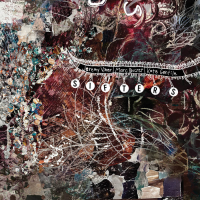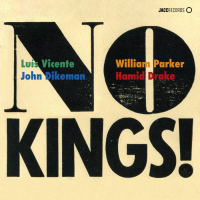Home » Jazz Articles » Album Review » Joshua Redman: Where Are We
Joshua Redman: Where Are We
Where We Are is his debut on the Blue Note label. It is a thematic musical journey across the USA. Every track (except the title track which closes the record) references a city or geographic location. It also features vocalist Gabrielle Cavassa on nine of the album's twelve tracks.
The first stop is "After Minneapolis (face toward mo[u]rning)." On it, Redman begins by quoting the melody of Woody Guthrie's "This Land Is Your Land" before beginning a short exploration of the tune and ending with a long, sustained note which leads into the piano playing single chords on the downbeat. Cavassa starts singing the lyrics written by Redman which reference the George Floyd killing over a dirge-like melody. Three minutes in, the band explodes onto the scene and Redman explores the pain and chaos of that tragedy before returning to the melody.
The next destination is Bruce Springsteen's Oscar Award-winning lament "Streets Of Philadelphia" Guest Kurt Rosenwinkel adds his unique sound which introduces the song before Cavassa enters. The interplay between Redmond and Rosenwinkel is very effective as the tune later turns more bluesy.
At this point, the album turns problematic. The remaining seven vocal tracks continue to have a slow, sameness to them. They are all ballads sung in a similar, lilting manner. Cavassa sings them all in a style reminiscent of Melody Gardot with her rich, sultry tone. "Chicago Blues" adds the vibes of Joel Ross which only increases the softening effect. The band is always empathetic, trying to create the space for Cavassa's vocals. "By The Time I Get To Phoenix" is done even more slowly than the original. "Do You Know What It Means To Miss New Orleans" is also taken at a languid pace. Guest Nicholas Payton on trumpet, along with Redman, plays a coda where they jam together in a New Orleans style, adding a welcome change of pace.
"My Heart In San Francisco (Holiday)" is a mash-up of the Thelonious Monk tune and the standard Tony Bennett made famous. The twist with the Monk tune is very clever and works well but, once again, it is sung in the same manner as the others. "That's New England," "Stars Fell On Alabama" and "Where We Are" are more of the same. There is some differentiation in the arrangements of course, but not enough to change the overall vibe.
The saving grace of this album is the three instrumentals. "Baltimore" is a beautiful arrangement where Redman and pianist Aaron Parks get a chance to expound on the haunting melody in a post-bop manner. "Manhattan" by Rogers & Hart, is the swinging mid-tempo song on the album. Guest guitarist Peter Bernstein shows his bluesy skills before Redman turns it up a notch. It is the rare fun piece on the record. John Coltrane's classic "Alabama" is the album's standout track. Redman channels Coltrane by going inside out. He solos through the entire track, showing off his deep tone and intricate ideas.
In the liner notes, Redman explains, "On one level, this is an album 'about' America—at once a celebration and a critique—but it is also, to varying degrees, a ballads album, a standards album, an album of romantic longing, an album of social reflection, an album of melodic invention, an album of improvisational adventure, an album of mash-ups, perhaps even a tribute album of sorts."
The ironic thing is while all the titles refer to many of the various and diverse parts of the country, the songs selected for the vocals, along with Cavassa's singing style, are anything but. Taken individually, they are all lovely, well-sung and well-played performances. The contributions of the four guest stars add some sizzle to their respective tracks and Redman with his core quartet is always solid but, taken as a whole, this album is less than the sum of its parts. It could have been so much more.
Track Listing
After Minneapolis (face toward mo[u]rning); Streets Of Philadelphia; Chicago Blues; Baltimore; By The Time I get To Phoenix; Do You Know What It Means To Miss New Orleans?; Manhattan; My Heart In San Francisco (Holiday); That’s New England; Alabama (Intro); Stars Fell On Alabama; Alabama; Where Are You?.
Personnel
Joshua Redman
saxophoneGabrielle Cavassa
vocalsAaron Parks
pianoJoe Sanders
bassBrian Blade
drumsAdditional Instrumentation
Kurt Rosenwinkel: guitar (2); Peter Bernstein: guitar (7); Nicholas Payton: trumpet (6); Joel Ross: vibes: (3); Gabrielle Cavassa: guitar (13).
Album information
Title: Where Are We | Year Released: 2023 | Record Label: Blue Note Records
Tags
PREVIOUS / NEXT
Joshua Redman Concerts
Support All About Jazz
 All About Jazz has been a pillar of jazz since 1995, championing it as an art form and, more importantly, supporting the musicians who make it. Our enduring commitment has made "AAJ" one of the most culturally important websites of its kind, read by hundreds of thousands of fans, musicians and industry figures every month.
All About Jazz has been a pillar of jazz since 1995, championing it as an art form and, more importantly, supporting the musicians who make it. Our enduring commitment has made "AAJ" one of the most culturally important websites of its kind, read by hundreds of thousands of fans, musicians and industry figures every month.
























